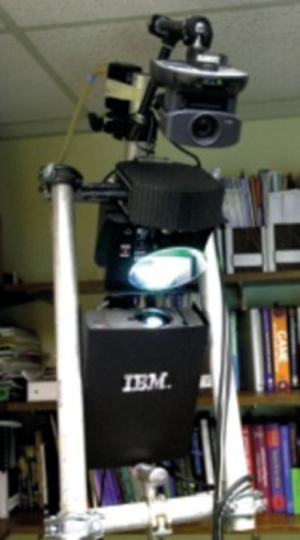“Everywhere Displays” by Pinhanez
Conference:
Experience Type(s):
E-Tech Type(s):
Entry Number: 06
Title:
- Everywhere Displays
Organizer(s)/Presenter(s):
Collaborator(s):
Description:
Pervasive computing envisions a world where it is possible to connect anytime and anywhere to all the devices and services that are linked by the Internet. Since most data present in the Internet today are designed to be accessed through a high-resolution graphical interface, to truly pervasively compute we have to carry laptops everywhere, wear computer graphics goggles, or install monitors and displays on the surfaces of spaces and objects and furniture.
Everywhere Displays (ED) explores an alternative approach to providing a graphical interface for pervasive computing. The idea is to couple an LCD projector to a motorized rotating mirror and a computer graphics system that can correct the distortion caused by oblique projection. As the mirror moves, different surfaces become available for displays. The display also uses computer-vision techniques to detect user hand interaction (such as pointing and clicking) with the projected image.
The goal is to develop a projection-based system that creates displays everywhere in an environment by transforming surfaces into projected “touch screens.” An Everywhere Displays projector can be installed on the ceiling of a space to provide a generic computer interface to users in an environment. For example, an ED projector in a store can transform pieces of white cardboard attached to shelves into interactive displays for product information. Similarly, an ED projector could be used in a home kitchen to access information, watch TV, read recipes, or simply set and control cooking time.
Everywhere displays propose a shift in the display paradigm where the display ceases to be regarded as a device to be installed in an environment or carried along by a user and becomes a service provided by a space. But like any paradigm shift, ED projectors not only solve a problem but also create a new set of applications. For instance, if information about the location and identity of objects in an environment is known, an ED projector can be used as a device to augment reality, without goggles! It can lead visitors to their destinations in a building by projecting arrows on the floor.
When visitors enter the space, they encounter an incomplete M&M picture and an invitation to interact projected beside the picture. When they touch the projected area to select an M&M color, the projector redirects its projection to point to the bin that contains M&Ms of that color. Visitors go to the bin indicated by the projector, pick up some M&Ms from the bin, and come back to the picture area. The projector points to the precise location where the M&M “pixels” should be placed. As visitors go through the exhibit, the picture emerges from their combined individual work.





